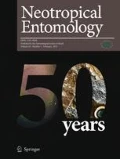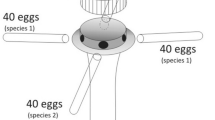Abstract
This study investigates the influence of parasitoid age and egg age of the hosts Euschistus heros (Fabricius) and Dichelops melacanthus (Dallas) on parasitism of Telenomus podisi Ashmead. Six separate bioassays were conducted: parasitism on eggs of E. heros (bioassay 1) and D. melacanthus (bioassay 2) by T. podisi females of different age (1, 5, and 10 days old); parasitism by T. podisi on eggs of different age (1, 2, 3, 4, and 5 days of embryonic development) of the hosts E. heros (bioassay 3) and D. melacanthus (bioassay 4); preference of T. podisi females for eggs at different embryonic developmental stages (eggs of 1, 2, 3, 4, and 5 days) of the hosts E. heros (bioassay 5) and D. melacanthus (bioassay 6). The age of T. podisi females and their hosts affected parasitism on both E. heros and D. melacanthus eggs. Overall, the parasitism rate was higher in older than younger parasitoids, independent of the tested host species, and host eggs between 1 and 3 days old were similarly parasitized. Thus, in T. podisi mass rearing facilities, it is recommended to use older adults (5 to 10 days old) as mother wasps to increase parasitism on the offered eggs. In addition, when hosts are completely absent in the field, or climatic conditions are unfavorable for release, mass-reared adults can be kept in the laboratory (25°C) for up to 10 days for later release in the field without any impairment of their subsequent parasitism performance.


Similar content being viewed by others
References
Abram PK (2016) Developmental, morphological, and behavioural plasticity in the reproductive strategies of stink bugs and their egg parasitoids. https://papyrus.bib.umontreal.ca/xmlui/bitstream/handle/1866/13586/Abram_Paul_2016_these.pdf?sequence=4&isAllowed=y. Accessed 26 Aug 2019.
Biever KD (1972) Effect of the temperature on rate of search by Trichogramma and its potential application in field releases. Environ Entomol 1:194–197
Borges Filho RC, Nava DE, Pratissoli D, Polanczyk RA, Marangon RB, Loiácono M (2017) Biology of Telenomus pachycoris (Hymenoptera: Scelionidae), a parasitoid of eggs of Pachycoris torridus (Hemiptera: Scutelleridae): the effects of egg age, exposure time, and temperature. Florida Entomol 100:375–380
Bueno AF, Batistela MJ, Bueno RCOF, França-Neto JB, Nishikawa MAN, Filho AL (2011) Effects of integrated pest management, biological control and prophylactic use of insecticides on the management and sustainability of soybean. Crop Prot 30:937–945
Bueno RCOF, Parra JRP, Bueno AF (2012) Trichogramma pretiosum parasitism of Pseudoplusia includens and Anticarsia gemmatalis eggs at different temperatures. Biol Control 60:154–162
Bueno AF, Corrêa-Ferreira BS, Roggia S, Bianco R (2015a) Silenciosos e daninhos. Rev Cult 196:25–27
Bueno AF, Bortolotto OC, Pomari-Fernandes A, França-Neto JB (2015b) Assessment of a more conservative stink bug economic threshold for managing stink bugs in Brazilian soybean. Crop Prot 71:132–137
Burr IW, Foster LA (1972) A test for equality of variances. Mimeo series n° 282. West Lafayette, Purdue University, p 26
Charnov EL, Los-Den Hartogh RL, Jones WT, Van Den Assem J (1981) Sex ratio evolution in a variable environment. Nature 289:27–33
Chiesa ACM, Sismeiro MNS, Pasini A, Roggia S (2016) Tratamento de sementes para manejo do percevejo‑barriga‑verde na cultura de soja e milho em sucessão. Pesq Agropec Bras 51:301–308
Cingolani M, Greco F, Nancy M, Liljesthrom GG (2014) Effect of Telenomus podisi, Trissolcus urichi, and Trissolcus basalis (Hymenoptera: Platygastridae) age on attack of Piezodorus guildinii (Hemiptera: Pentatomidae) eggs. Environ Entomol 43:377–383
Cock MJW, van Lenteren JC, Brodeur J, Barratt BIP, Bigler F, Bolckmans K, Cônsoli FL, Haas F, Mason PG, Parra JRP (2010) Do new access and benefit sharing procedures under the convention on biological diversity threaten the future of biological control? BioControl 55:199–218
Colazza S, Rosi MC (2001) Differences in the searching behavior of two strains of the egg parasitoid Telenomus busseolae (Hymenoptera: Scelionidae). Eur J Entomol 98:47–52
Cônsoli FL, Kitajima EW, Parra JRP (1999) Ultrastructure of the natural and factitious host eggs of Trichogramma galloi Zucchi and Trichogramma pretiosum Riley (Hymenoptera: Trichogrammatidae). Int J Insect Morphol 28:211–229
Corrêa-Ferreira BS, Moscardi F (1995) Seasonal occurrence and host spectrum of egg parasitoids associated with soybean stink bugs. Biol Control 5:196–202
Corrêa-Ferreira BS, Zamataro CEO (1989) Capacidade reproductiva e longevidade dos parasito’ ides de ovos Trissolcus basalis (Wollaston) e Trissolcus mitsukurii Ashmead (Hymenoptera: Scelionidae). Rev Bras Biol 49:621–626
Corrêa-Ferreira BS, Azevedo J (2002) Soybean seed damage by different species of stink bugs. Agric Forest Entomol 4:145–150
Cunningham RT, Farias GJ, Nakagawa S, Chambers DL (1971) Reproduction in the Mediterranean fruit fly: depletion of stored sperm in female. Ann Entomol Soc Am 64:312–313
Fisher RC (1981) Efficiency of parasites in assimilating host tissues into their own. Parasitology 82:33–34
Godfray HCJ (1994) Parasitoids: behavioral and evolutionary ecology. Princeton University Press, Princeton, p 488
Houseweart MW, Jennings DT, Welty C, Southard SG (1983) Progeny production by Trichogramma minutum (Hymenoptera: Trichogrammatidae) utilizing eggs for Choristoneura fumiferana (Lepidoptera: Tortricidae) and Sitotroga cerealella (Lepidoptera: Gelechiidae). Can Entomol 115:1245–1252
King BH (1987) Offspring sex ratios in parasitoid wasps. Q Rev Biol 62:367–369
Laumann RA, Moraes MCB, Silva JPD, Vieira AMC, Silveira SD, Borges M (2010) Egg parasitoid wasps as natural enemies of the neotropical stink bug Dichelops melacanthus. Pesq Agropec Bras 45:442–449
McDougall SJ, Mills NJ (1997) The influence of hosts, temperature and food sources on the longevity of Trichogramma platneri. Entomol Exp Appl 83:195–203
Michaud JP (2018) Problems inherent to augmentation of natural enemies in open agriculture. Neotrop Entomol 47:161–170
Pak GA, Buis HCEM, Heck ICC, Hermans MLG (1986) Behavioural variations among strains of Trichogramma spp.: host-age selection. Entomol Exp Appl 40:247–258
Panizzi AR (2013) History and contemporary perspectives of the integrated pest management of soybean in Brazil. Neotrop Entomol 42:119–127
Panizzi AR, Corrêa-Ferreira BS (1997) Dynamics in the insect fauna adaptation to soybean in the tropics. Trends Entomol 1:71–88
Panizzi AR, Slansky FJR (1985) Review of phytophagous pentatomids (Hemiptera: Pentatomidae) associated with soybean in the Americas. Fla Entomol 68:184–203
Panizzi AR, Parra JRP, Santos CH, Carvalho DR (2000) Rearing the southern green stink bug using artificial dry diet and artificial plant. Pesq Agropec Bras 35:1709–1715
Papaj DR (2000) Ovarian dynamics and host use. Annu Rev Entomol 45:423–448
Peres WAA, Corrêa-Ferreira BS (2004) Methodology of mass multiplication of Telenomus podisi Ashmead and Trissolcus basalis (Hymenoptera: Scelionidae) on eggs of Euschistus heros (Hemiptera: Pentatomidae). Neotrop Entomol 33:457–462
Powell JE, Shepard BM (1982) Biology of Australian and United States strains of Trissolcus basalis, a parasitoid of the green vegetable bug Nezara viridula. Austral Ecol 7:181–186
Pratissoli D, Kloss TG, Zinger FD, Carvalho JR, Vianna UR, Paes JP (2014) Does mating interfere in the biological characteristics of a population of Trichogramma pretiosum? An Acad Bras Ciênc 86:459–464
Queiroz AP, Bueno AF, Pomari-Fernandes A, Grande MLM, Bortolotto OC, Silva DM (2017) Quality control of Telenomus remus (Hymenoptera: Platygastridae) reared on the factitious host Corcyra cephalonica (Lepidoptera: Pyralidae) for successive generations. B Entomol Res 107:791–798
Queiroz AP, Taguti EA, Bueno AF, Grande MLM, Costa C (2018) Host preferences of Telenomus podisi (Hymenoptera: Scelionidae): parasitism on eggs of Dichelops melacanthus, Euschistus heros, and Podisus nigrispinus (Hemiptera: Pentatomidae). Neotrop Entomol 47:543–552
Queiroz AP, Favetti BM, Luski PGG, Gonçalvez J, Neves POJ, Bueno AF (2019) Telenomus remus (Hymenoptera: Platygastridae) parasitism on Spodoptera frugiperda (Lepidoptera: Noctuidae) eggs: different parasitoid and host egg ages. Semina Ciên Agr 40:2933–2946
Querino RB, Silva NN, Zucchi RA (2016) Natural parasitism by Trichogramma spp. in agroecosystems of the Mid-North, Brazil. Ciênc Rural 46:1521–1523
SAS Institute (2009) SAS User’s guide: statistics, Version 8e. SAS Institute, Cary
Schwartz A, Gerling D (1974) Adult biology of Telenomus remus (Hymenoptera: Scelionidae) under laboratory conditions. Entomophaga 19:482–492
Shapiro SS, Wilk MB (1965) An analysis of variance test for normality (complete samples). Biometrika 52:591–611
Silva CC, Laumann RA, Blassioli MC, Pareja M, Borges M (2008) Euschistus heros mass rearing technique for the multiplication of Telenomus podisi. Pesq Agropec Bras 43:575–580
Slansky F (1986) Nutritional ecology of endoparasitic insects and their hosts: an overview. J Insect Physiol 32:255–261
Sosa-Gómez DR, Silva JJD (2010) Neotropical brown stink bug (Euschistus heros) resistance to methamidophos in Paraná, Brazil. Pesq Agrop Brasileira 45:767–769
Sosa-Gómez DR, Corso IC, Morales L (2001) Insecticide resistance to endosulfan, monocrotophos and methamidophos in the neotropical brown stink bug. Euschistus heros (F) Neotrop Entomol 30:317–320
Stephens DW, Krebs JR (1986) Foraging theory. Princeton University Press, Princeton
Thomson LJ, Hoffmann AA (2002) Laboratory fecundity as predictor of field success in Trichogramma carverae (Hymenoptera: Trichogrammatidae). J Econ Entomol 95:912–917
Thuler RT, Volpe HXL, Bortoli AS, Goulart RM, Viana CLT (2007) Metodologia para avaliação da preferência hospedeira de parasitoides do gênero Trichogramma Westood. Bol Sanid Veg 33:333–340
Valente ECN, Broglio SMF, Passos EMD, Lima ASTD (2016) Performance of Trichogramma galloi (Hymenoptera: Trichogrammatidae) on eggs of Diatraea spp. (Lepidoptera: Crambidae). Pesq Agropec Bras 51:293–300
van Lenteren JC, Bueno VHP (2003) Augmentative biological control of arthropods in Latin America. Biocontrol 48:123–139
van Lenteren JC, Tommasini M (2002) Mass production, storage, shipment and quality control of natural enemies. In: Albajes R, Gullino ML, van Lenteren JC, Elad Y (eds) Mass production, storage, shipment and quality control of natural enemies, integrated pest and disease management in greenhouse crops. Springer, Dordrech, pp 276–294
van Lenteren JC, Tommasini MG (2003) Mass production, storage, shipment and release of natural enemies. In: van Lenteren JC (ed) Quality control and production of biological control agents: theory and testing procedures. Cabi, Wallingford, pp 181–189
van Lenteren JC, Bolckmans K, Köhl J, Ravensberg WJ, Urbaneja A (2018) Biological control using invertebrates and microorganisms: plenty of new opportunities. BioControl 63:39–59
Vinson SB (1997) Comportamento de seleção hospedeira de parasitoides de ovos, com ênfase na família Trichogrammatidae. In: JRP P, Zucchi RA (eds) Trichogramma e o Controle Aplicado. Fundação de Estudos Agrários Luiz de Queiroz, Piracicaba, pp 67–119
Vinson SB, Iwantsch (1980) Host suitability for insect parasitoids. Annu Rev Entomol 25:397–419
Wiegart RG, Peterson CE (1983) Energy transfer in insects. Annu Rev Entomol 28:455–486
Zhou Y, Abram PK, Boivin G, Brodeur J (2014) Increasing host age does not have the expected negative effects on the fitness parameters of an egg parasitoid. Entomol Exp Appl 151:106–111
Acknowledgments
The authors thank Embrapa Soja, the Coordination for the Improvement of Higher Education Personnel (CAPES), and the National Council for Scientific and Technological Development (CNPq) for their financial support and fellowships.
Author information
Authors and Affiliations
Contributions
AP Queiroz, AF Bueno, and AR Panizzi contributed to the study design and wrote the paper. AP Queiroz conducted the sampling. AF Bueno and AR Panizzi contributed reagents/material/analysis tools. AP Queiroz, BM Favetti, R Hayahida, MLM Grande, and MN Neiva conducted the experiments. All authors have read and approved the manuscript.
Corresponding author
Additional information
Edited by Raúl A Laumann – Embrapa
Publisher’s Note
Springer Nature remains neutral with regard to jurisdictional claims in published maps and institutional affiliations.
Rights and permissions
About this article
Cite this article
Queiroz, A.P., Favetti, B.M., Hayashida, R. et al. Effect of the Ages of Parasitoid and Host Eggs on Telenomus podisi (Hymenoptera: Platygastridae) Parasitism. Neotrop Entomol 48, 974–982 (2019). https://doi.org/10.1007/s13744-019-00724-2
Received:
Accepted:
Published:
Issue Date:
DOI: https://doi.org/10.1007/s13744-019-00724-2



